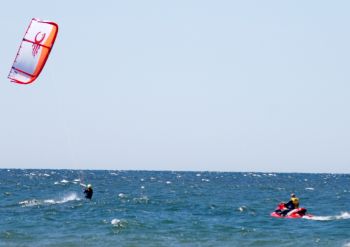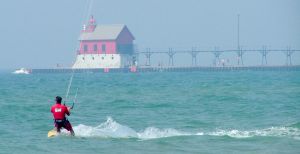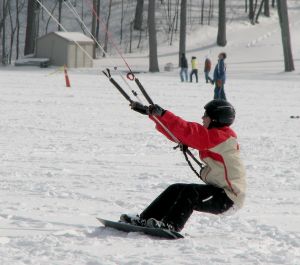Kiteboarding Locations
Where can I kiteboard? Lake Michigan offers literally hundreds of miles of open beach. Use this to your advantage. Don't try to launch or land at a crowded beach; you need at least 100 yards of open area to launch a kite safely. Also, before you even set up your kite, think about what is going to happen if you get blown downwind. Launching with a pier downwind of you is not a good idea; neither is launching at a site where you could be blown past the end of a point. Stay close to shore, 100-150 yards, so that if you do have to swim in, you will be able to do so without help. And make sure you've got a buddy that can help you out, whether it's with a boat, jetski, or another more experienced kiteboarder. Remember, if the wind is blowing you away from the beach, do not put up a kite. Find a beach where the wind direction is more suited for kiteboarding, or find something else to do that day. For local riding spots, see Michigan Kiteboard locations.
Lake Michigan offers literally hundreds of miles of open beach. Use this to your advantage. Don't try to launch or land at a crowded beach; you need at least 100 yards of open area to launch a kite safely. Also, before you even set up your kite, think about what is going to happen if you get blown downwind. Launching with a pier downwind of you is not a good idea; neither is launching at a site where you could be blown past the end of a point. Stay close to shore, 100-150 yards, so that if you do have to swim in, you will be able to do so without help. And make sure you've got a buddy that can help you out, whether it's with a boat, jetski, or another more experienced kiteboarder. Remember, if the wind is blowing you away from the beach, do not put up a kite. Find a beach where the wind direction is more suited for kiteboarding, or find something else to do that day. For local riding spots, see Michigan Kiteboard locations.
Inland lakes can be used for kiteboarding, however they need to be of sufficient size to allow you to launch and land a kite safely, and have minimal wind interferences from trees or hills. Wind flows over and around obstacles with strange results. This is why most of us choose to kite on Lake Michigan; the winds have no interference for at least 60 miles.

Where's the easiest place to learn during and after a lesson?
Downwind of a pier, meaning if you drop your kite you will not be blown toward the pier. This offers flatter water than an exposed beach. If the wind is blowing from the South, you'd want to ride on the North side of the pier. The pier would block the waves, and you'd have one less thing to deal with while working on your skills. Even advanced riders seek out piers; they can ride flat water, or head further downwind to find nice clean waves that have been filtered by the breakwalls.
Snowkite? Use a kite on the snow with a snowboard or skis. Sounds hard? It's very easy. Snowkiting allows you to build kiteboarding skills without having to swim in, deal with wave action, etc. Not to mention it's a blast. I was a ski instructor for 3 years, ran trips for a ski club in college, and now have not purchased a lift ticket in 2 years because I find snowkiting much more enjoyable than waiting in line for a chairlift to take a 2 min run. And yes, we offer snowkiting lessons as well. I strongly encourage anyone who skis or snowboards to at least try snowkiting. All you need is a safely frozen lake with a few inches of snow, or a snow-covered field, some protective gear (helmet and pads) and a kite. As you progress you will want a harness and best of all, you can use your kiteboarding kite in the snow.
Use a kite on the snow with a snowboard or skis. Sounds hard? It's very easy. Snowkiting allows you to build kiteboarding skills without having to swim in, deal with wave action, etc. Not to mention it's a blast. I was a ski instructor for 3 years, ran trips for a ski club in college, and now have not purchased a lift ticket in 2 years because I find snowkiting much more enjoyable than waiting in line for a chairlift to take a 2 min run. And yes, we offer snowkiting lessons as well. I strongly encourage anyone who skis or snowboards to at least try snowkiting. All you need is a safely frozen lake with a few inches of snow, or a snow-covered field, some protective gear (helmet and pads) and a kite. As you progress you will want a harness and best of all, you can use your kiteboarding kite in the snow.
Snowkiting skills translate directly into kiteboarding on the water, and in general learning the basics on the snow is much easier. You are already standing on a flat surface, there are no waves to throw you off balance, and you need a lot less power to get moving. Relaunching a kite is also much easier on the snow. See our Snowkiting FAQ page for more information.
Continue to 'Learning to Kiteboard'
Return to the Kiteboarding Knowledge Center
